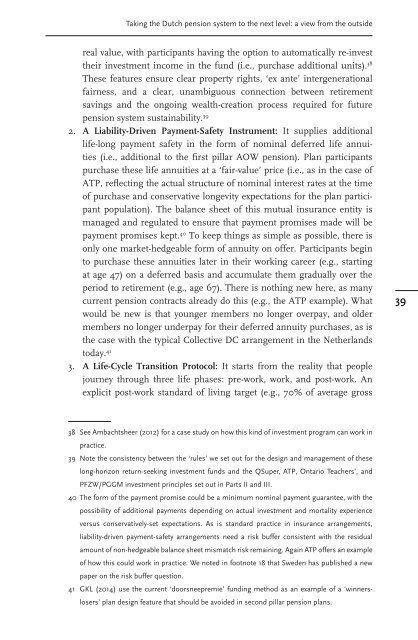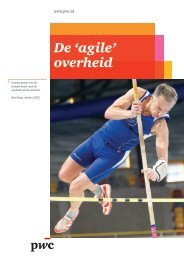Toekomst voor aanvullende pensioenen
Toekomst voor aanvullende pensioenen
Toekomst voor aanvullende pensioenen
- No tags were found...
You also want an ePaper? Increase the reach of your titles
YUMPU automatically turns print PDFs into web optimized ePapers that Google loves.
Taking the Dutch pension system to the next level: a view from the outsidereal value, with participants having the option to automatically re-investtheir investment income in the fund (i.e., purchase additional units). 38These features ensure clear property rights, ‘ex ante’ intergenerationalfairness, and a clear, unambiguous connection between retirementsavings and the ongoing wealth-creation process required for futurepension system sustainability. 392. A Liability-Driven Payment-Safety Instrument: It supplies additionallife-long payment safety in the form of nominal deferred life annuities(i.e., additional to the first pillar AOW pension). Plan participantspurchase these life annuities at a ‘fair-value’ price (i.e., as in the case ofATP, reflecting the actual structure of nominal interest rates at the timeof purchase and conservative longevity expectations for the plan participantpopulation). The balance sheet of this mutual insurance entity ismanaged and regulated to ensure that payment promises made will bepayment promises kept. 40 To keep things as simple as possible, there isonly one market-hedgeable form of annuity on offer. Participants beginto purchase these annuities later in their working career (e.g., startingat age 47) on a deferred basis and accumulate them gradually over theperiod to retirement (e.g., age 67). There is nothing new here, as manycurrent pension contracts already do this (e.g., the ATP example). Whatwould be new is that younger members no longer overpay, and oldermembers no longer underpay for their deferred annuity purchases, as isthe case with the typical Collective DC arrangement in the Netherlandstoday. 413. A Life-Cycle Transition Protocol: It starts from the reality that peoplejourney through three life phases: pre-work, work, and post-work. Anexplicit post-work standard of living target (e.g., 70% of average gross3938 See Ambachtsheer (2012) for a case study on how this kind of investment program can work inpractice.39 Note the consistency between the ‘rules’ we set out for the design and management of theselong-horizon return-seeking investment funds and the QSuper, ATP, Ontario Teachers’, andPFZW/PGGM investment principles set out in Parts II and III.40 The form of the payment promise could be a minimum nominal payment guarantee, with thepossibility of additional payments depending on actual investment and mortality experienceversus conservatively-set expectations. As is standard practice in insurance arrangements,liability-driven payment-safety arrangements need a risk buffer consistent with the residualamount of non-hedgeable balance sheet mismatch risk remaining. Again ATP offers an exampleof how this could work in practice. We noted in footnote 18 that Sweden has published a newpaper on the risk buffer question.41 GKL (2014) use the current ‘doorsneepremie’ funding method as an example of a ‘winnerslosers’plan design feature that should be avoided in second pillar pension plans.




![Proefschrift Hanneke A. Luth[lr]](https://img.yumpu.com/51055008/1/178x260/proefschrift-hanneke-a-luthlr.jpg?quality=85)

![Proefschrift Hanneke A. Luth[lr]](https://img.yumpu.com/24018368/1/178x260/proefschrift-hanneke-a-luthlr.jpg?quality=85)